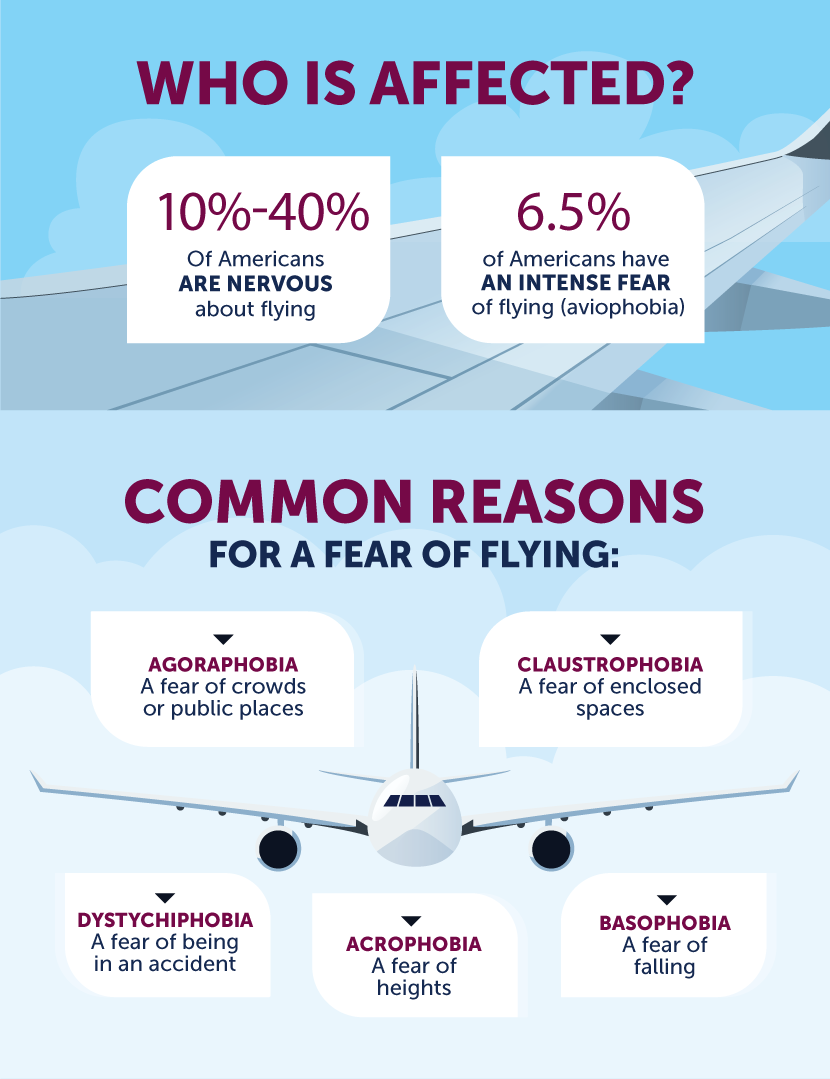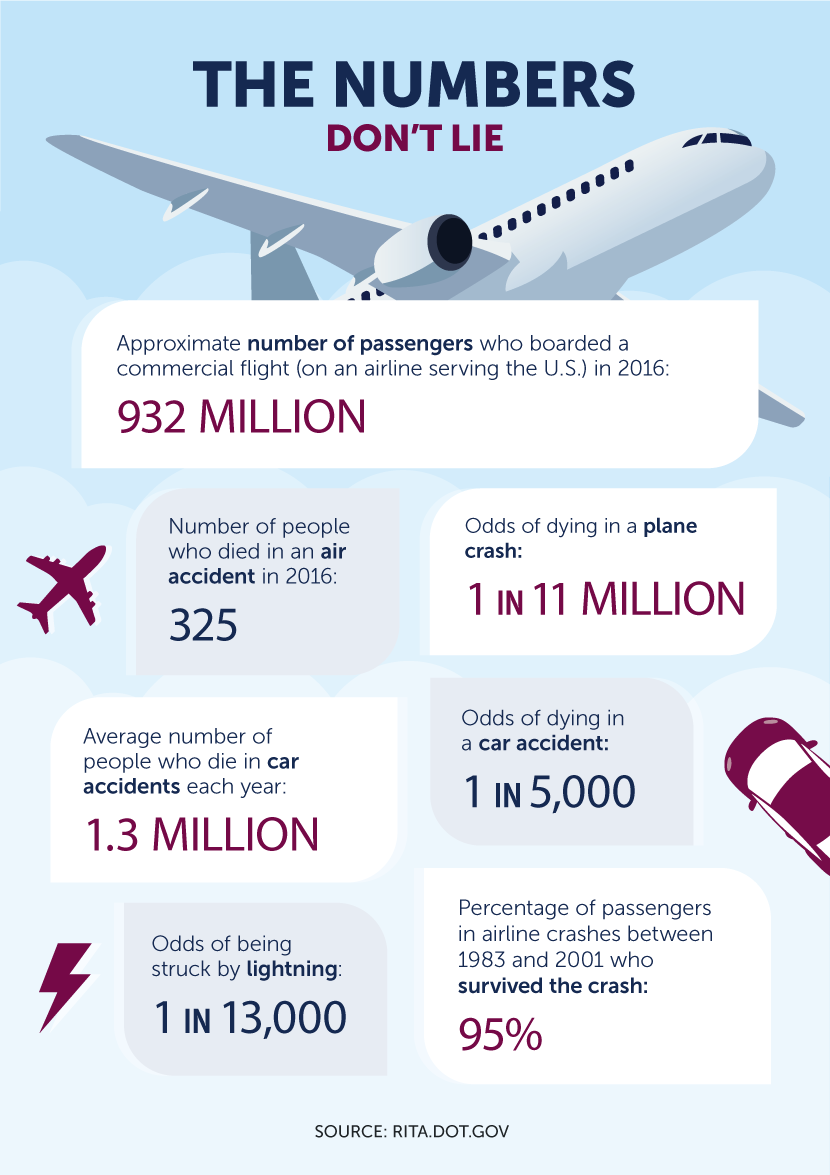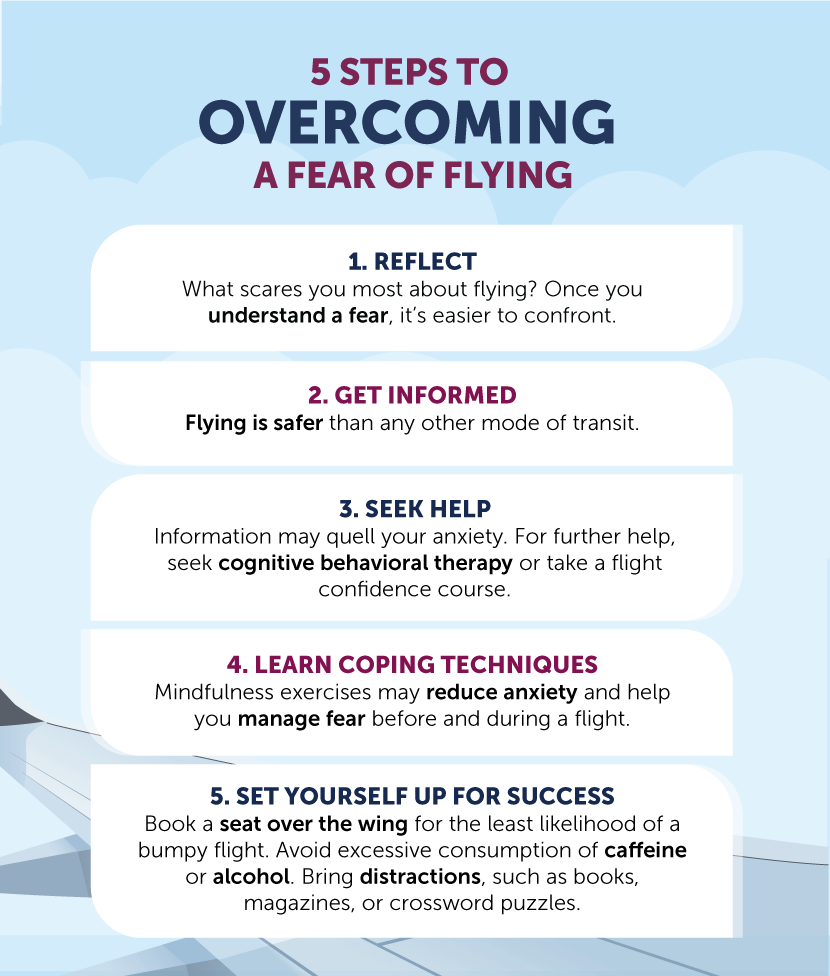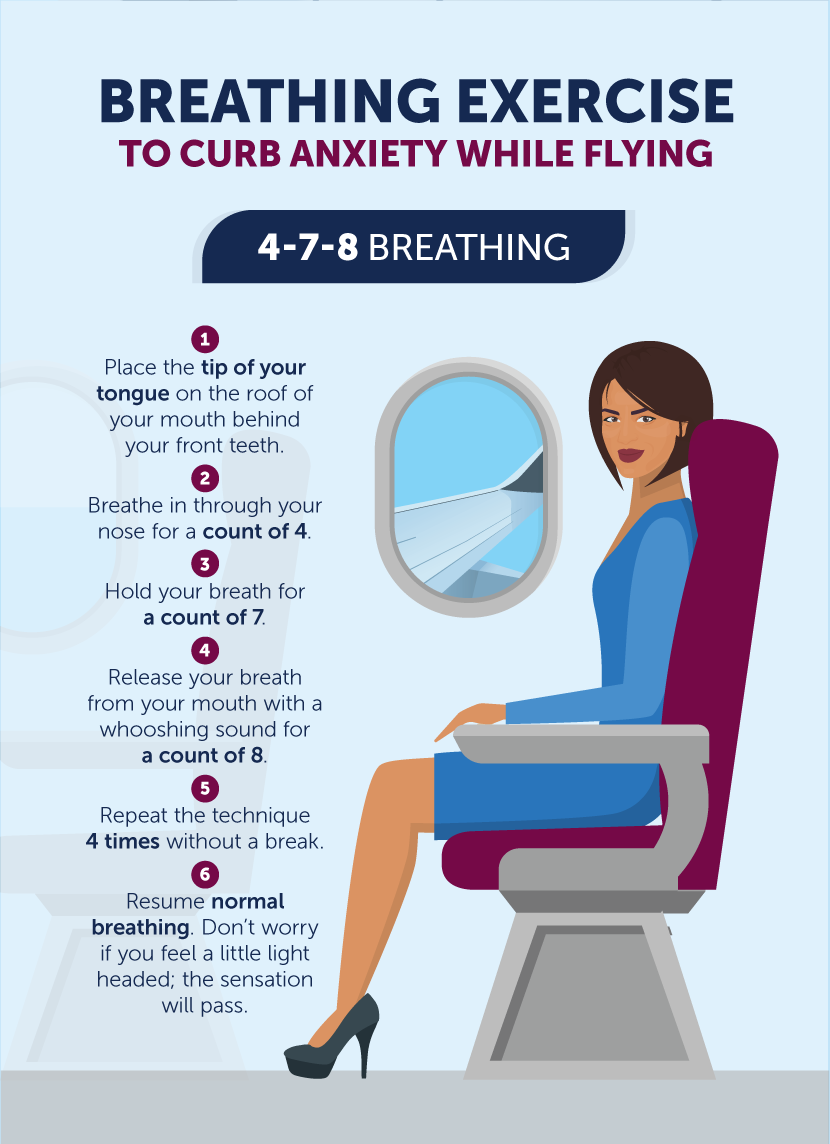Conquering the Fear of Flying
Anxious about air travel? You’re not alone.
Soaring 39,000 feet above the ground in a crowded airliner with a stranger at the controls is an inherently uncomfortable situation
for many people. Between 10 and 40 percent of people report some anxiety about flying,
and an estimated 6.5 percent have an intense fear of flying.https://www.ncbi.nlm.nih.gov/pmc/articles/PMC2760591/http://www.nytimes.com/2007/07/24/health/psychology/24fear.html
Some travelers opt for other modes of transit.
But avoiding flying can hurt your quality of life. It may keep you from furthering a career, seeing loved ones,
or visiting a dream destination. If you’re holding off on a trip because of flight anxiety, it’s time to conquer your fear!
Keep reading to learn why flying is actually the safest way to get somewhere and discover proven ways to ease your anxiety
over air travel.

Arm Yourself with Facts
Fear is often irrational, but it can be helpful to distinguish actual danger from anxiety.
Here’s the bottom line: Air travel is extremely safe.
You’re much more likely to get hit by lightning than you are to die in an airplane crash.http://www.nydailynews.com/news/national/common-plane-crashes-expert-weighs-deadly-week-article-1.1879212
Driving a car is familiar and offers more personal control than flying,
thus many people think it’s safer than air travel. However, driving is far more dangerous.
By one estimate, driving a car or truck is 100 times deadlier than commercial air travel.https://journalistsresource.org/studies/environment/transportation/comparing-fatality-risks-united-states-transportation-across-modes-time
After September 11, millions of Americans opted for cars over airplanes, and according to one analysis,
1,591 more drivers than usual died in accidents during the next 12 months as a result.https://www.theguardian.com/world/2011/sep/05/september-11-road-deaths

Why is flying so safe? The airline industry employs strict safety standards and is highly regulated.
Think about it this way: What if every driver was trained for hundreds of hours, a team of mechanics spent 11 to 12 hours
for each hour on the road meticulously maintaining every automobile, and thousands of professionals carefully monitored each car
trip to ensure safe, orderly, and efficient travel? If that were the case, automobile travel would be as safe as air travel,
which is by far the safest mode of transit per mile.https://www.hthtravelinsurance.com/travel_center/general/ne_el_11.cfm
Hundreds of millions of passengers fly on commercial planes every year, and nearly all land safely.
In 2016, 325 people worldwide died in plane crashes, amounting to one fatality per 10,769,230 passengers.
Those are incredible odds, especially when you consider that one in 623 pedestrians die in accidents just walking around town.http://www.telegraph.co.uk/travel/advice/2016-air-accidents-aviation-safety/
Turbulence, air currents that make planes shift, bump, and drop in altitude,
can make even experienced travelers feel nervous and nauseous. Here’s what you need to know about turbulence:
It’s not fun, but it doesn’t present a danger to an airplane.
About 20 passengers every year sustain injuries from falling or spilling a hot beverage when a plane hits an air current.http://www.telegraph.co.uk/travel/travel-truths/turbulence-explained-is-it-dangerous/ Turbulence has never caused an airplane to crash.http://www.independent.co.uk/travel/news-and-advice/why-fear-of-flying-is-just-plane-stupid-1770229.html
Learning about the airline industry’s safety record is enough to help many anxious travelers feel confident enough to fly.
Many airlines offer one- to two-day courses for people with flight phobia in which participants learn about pilot training,
airplane maintenance, and air-traffic-control operations, as well as in-flight relaxation techniques.
Virgin Airlines claims a 98 percent success rate for its class. Nearly all participants are comfortable enough to board the
practice flight at the end of the day-long course.https://www.flyingwithoutfear.co.uk/

Prepare for Takeoff
Once you understand rational reasons to feel confident about air travel, it’s time to grapple with your emotions.
It’s uncomfortable to confront fear, and it may help to have a strong reason for doing so.
You probably have something positive to look forward to at the end of your first flight,
whether it’s seeing a family member or visiting a beautiful destination. Keep your destination in mind as you commit to
adopting skills to manage your emotions before and during a flight.
Your breathing is an important key for altering your emotions. When a person is upset,
the breath becomes quick and shallow to activate the body’s fight-or-flight response.
When there’s no actual threat, a person may take in too much air and hyperventilate,
leading to symptoms such as shortness of breath, weak or tingling limbs, chest pains, dizziness, and rapid heartbeat.
These sensations can feel terrifying when a person is already anxious.
You’ll have a built-in tool for feeling calmer if you learn to breathe slowly when you’re upset.
A slow-breathing technique such as 4-7-8 Breathing (described in the illustration below) can be a powerful way to quickly curb
anxiety.http://www.calmclinic.com/anxiety/symptoms/hyperventilationhttps://www.drweil.com/videos-features/videos/the-4-7-8-breath-health-benefits-demonstration/

However, it can be difficult to recognize and react to what’s happening in the body when you’re upset. Regularly practicing mindfulness is one way to become more aware and
accepting of what you’re experiencing in the present moment.
Research indicates that mindfulness meditation helps relieve generalized anxiety. Furthermore, in only two months,
mindfulness meditation can actually restructure the brain in ways that alter the body’s stress response.https://www.forbes.com/sites/alicegwalton/2017/01/26/mindfulness-meditation-may-help-treat-anxiety-disorders/#25a79ac512ad
In an eight-week Harvard University study, participants paid attention to their breathing for an average of 27 minutes a day.
Researchers compared scans of the subjects’ brains before and after and noted a thickening of key regions involved in awareness,
learning, and compassion and shrinkage in the amygdala, the fight-or-flight center of the brain.https://www.washingtonpost.com/news/inspired-life/wp/2015/05/26/harvard-neuroscientist-meditation-not-only-reduces-stress-it-literally-changes-your-brain/?utm_term=.f7cb1d7f1d3d
One caveat: Breath-awareness meditation triggers anxiety in some people.https://www.theguardian.com/lifeandstyle/2016/jan/23/is-mindfulness-making-us-ill
These people may feel calmer when practicing other mindfulness techniques, such as yoga or qigong, guided meditations,
or soothing mantras.https://www.elephantjournal.com/2015/12/the-downside-of-mindfulness-for-the-anxious-mind-what-to-do-about-it/ No matter which mindfulness practice you choose, relaxing may allow strong emotions to surface for
some people. It may be helpful to pair a mindfulness practice with cognitive behavioral therapy tailored for flight phobia.
In therapy, nervous travelers explore what scares them about flying and learn skills to manage anxiety before and during a flight,
such as relaxation exercises and talking back to negative thoughts.https://adaa.org/living-with-anxiety/ask-and-learn/ask-expert/how-can-i-overcome-my-fear-of-flying Meanwhile, they gradually expose themselves to flight in a virtual-reality context or in a supportive, real-life environment.https://www.ncbi.nlm.nih.gov/pmc/articles/PMC2760591/
Air catastrophes happen (very rarely), and we’ve all seen scary footage of plane crashes on the news. But flying is safer than any other form of transit. Don’t let a fear of air travel keep you from your next adventure. Begin confronting your anxiety,
and eventually you’ll be able to sit back and enjoy, or at least tolerate, your next flight.
Embed the article on your site

